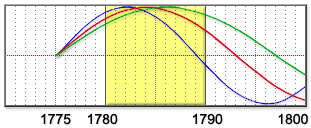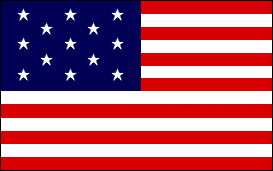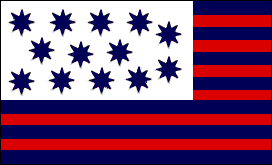Years in This Page:

|
|
|
This Overview is a brief look at the time and the influence of Cycles. Significant events from each year are noted along with the position of the Cycles to show how history is moving in Rhythm. Enjoy the walk through history.
See the go to Timelines here link near the top for a detailed look at Cycles for this decade.
See the Matrix links above left for navigating through all Overviews and Timelines by Time, Subject, or Cycle as described in Introduction to Part II.
click to enlarge
 |
The Revolutionary War continued until the Americans defeated the British in 1781 and the Treaty of Paris in 1784 made it official. American industry grew trade began with China in 1784. Congress proposed dividing the western territories into states in 1784 and dividing the northwest territories into townships in 1785. Congress made New York City the temporary federal seat in 1788 and Washington D.C. was established to become the new home of the capital. Daniel Shays led a revolt against the Massachusetts state government over high taxes and a failing economy in 1786 he failed against the new government and its federal arsenal. Congress adopted a monetary system and began the first mint that same year. Virginia legislature passed its Ordinance of Religious Freedom guaranteeing religious rights in 1786. The US Constitution, drafted in 1787, formed the Executive, Legislative and Judicial branches of government. Congress elected George Washington as the first president and John Adams as vice-President in 1789. America laid its foundation during the rising First Quarters of the Cycles, all of which peaked in this decade to go into their Second Quarters of Improvement and Improvement. A new swing of expansion would gain momentum by decade's end decade and even the earliest pangs of reform would begin as the Physical Cycle began its Third Quarter of Reform. |
top
| |
March 21, 1780 - |
| |
March 21, 1781 |
|
|
1780: Women riders appeared in horse racing in 1780 in Long Island, New York during this first Physo-Intellectual High as subsequent Highs of this combination would bring more women into sports. The appearance of women reflected the Emotional High and that they were in the genre of activity reflected the Physical The first Emotional High raised morality and the first laws against slavery emerged as the Pennsylvania assembly enacted legislation for the gradual abolition of slavery and Massachusetts endorsed its constitution on that held "All men are born free and equal" which they asserted applies also to slaves. Other states would soon follow in this Quarter. The American Academy of Arts and Sciences founded in Boston during our first Intellectual 1st Qtr. of Foundation. The American Academy of Arts an Sciences was founded and the Philadelphia Humane Society was established in 1780 during this first Emo-Intellectual 1st Qtr. of Foundation. |
top
| |
March 21, 1781 - |
| |
March 21, 1782 |
|
|
1781: The End of the Revolutionary War came with an American defeat of the British. Now the nation's energies would turn inward and focus toward growth. John Stevens invented multi-tubular steam engine and Jeremiah Wilkinson produced cold-cut iron nails from iron plate in the Physical 1st Qtr. of Foundation. Thomas Jefferson wrote "Notes on Virginia" that defined the state and physical boundaries and natural history from 1781-1784 during our first Physical High. The Bank of North America was established by Congress and the Massachusetts Medical Society was Established by Cotton Tufts in the Intellectual 1st Qtr. of Foundation. The Articles of Confederation and Perpetual Union were ratified in to establish the governing of a new nation during our first Trirhythmic 1st Qtr. of Foundation. |
top
| |
March 21, 1782 - |
| |
March 21, 1783 |
|
|
1782: The Great Seal of the United States was adopted in 1782 at the peak of the Physical High to mark our identity. The first complete English language Bible published in America came in this Emotional 1st Qtr. of Foundation. Use of scarlet letter for adulterers in New England was discontinued as the first Emotional High brought more permissiveness. Harvard Medical School opened in the Intellectual 1st Qtr. of Foundation. "Letters from an American Farmer" by J. Hector St. John de Crevecoeur contained warm and vivid detail of farm life, animals the geography of the colonies and the goodness of man that is traced from his connections with soil became extremely popular in the Trirhythmic High. |
top
| |
March 21, 1783 - |
| |
March 21, 1784 |
|
|
1783: The first Protestant Episcopal bishop in America, Dr. Samuel Seabury, was elected in Connecticut during the Emotional 1st Qtr. of Foundation. Webster standardized American English and published "The American Speller," the first daily newspaper in the US - "The Pennsylvania Evening Post" was published in Philadelphia, and Benjamin Franklin invented bifocal spectacles during the Intellectual 1st Qtr. of Foundation. America's first dentist, Josiah Flagg of Boston, set up shop and Benjamin Franklin invented bifocal spectacles in this Physo-Intellectual High. |
top
| |
March 21, 1784 - |
| |
March 21, 1785 |
|
|
1784: America opened a trade route to China and "and "Geography Made Easy" was published by Jeridiah Morse that included descriptions of American plants and animals during our first Physical High. Automatic production line in a flour mill was established by Oliver Evans and Andrew Ellicot surveyed and extended the Mason-Dixon Line in the Physical 2nd Qtr. Improvements. The first theological college in the US, the New Brunswick Theological Seminary was established in New Jersey and periodicals designed especially for women appeared as "Gentlemen and Ladies" and "Town and Country Magazine," as this Emotional 1st Qtr. of Foundation brought the Cycle to its peak this year. Congress officially created a Treasury Board, balloon experiments were advanced by physician, John Foulke, and by Peter Carnes in the Intellectual 1st Qtr. of Foundation. The first theological college in the U.S. was established in New Hampshire and the first Catholic parochial school ("Mother School") in Philadelphia, and periodicals designed especially for women appeared as "Gentlemen and Ladies" and "Town and Country Magazine," in the Emo-Intellectual High. |
top
| |
March 21, 1785 - |
| |
March 21, 1786 |
|
|
1785: The Stage Route began and the Virginia Turnpike began during the Physical High. The Continental Congress that a section of each township in the Western Reserve (north-east Ohio) be set aside for the support of public schools, the first free school was established for Orphans in Virginia in this Intellectual 1st Qtr. of Foundation. The first issue of "Memoirs, the Journal of the American Academy of Arts and Sciences" was published in the Emo-Intellectual High. |
top
| |
March 21, 1786 - |
| |
March 21, 1787 |
|
|
1786: Boats became steam powered during Physical 2nd Qtr. Improvements. A golf club was established in South Carolina in the Physical High. Virginia's Ordinance of Religious Freedom expanded beyond its Declaration of Rights (of 1776) during Emotional 2nd Qtr. Improvements. The first publication with movable type appeared, Rittenhouse Described the Molecular Theory of Magnetism, and Dr. Benjamin Rush suggested that some illnesses are psychosomatic during the Intellectual 1st Qtr. of Foundation. |
top
| |
March 21, 1787 - |
| |
March 21, 1788 |
|
|
1787: The first American cotton mill opened in Massachusetts during the Physical High. Oliver Evans Improved Steam Engines with the non-condensing high-pressure steam engine and Rumsey built the "Jet-propelled" steamboat that shoots a stream of water through the stern in the Physical 2nd Qtr. Improvements. The first American comedy "The Contrast" began on stage in New York City in the Emotional High. Serial publication advanced as a leading means and the first of the "The Federalist" papers began in the Intellectual 2nd Qtr. Improvements. Wistar and Mitchill conducted independent experiments on evaporation and The College of Physicians of Philadelphia was Founded in the Physo-Intellectual High. |
top
| |
March 21, 1788 - |
| |
March 21, 1789 |
|
|
1788: Shipbuilding expanded to the West coast when "Northwest America" was launched in the Physical 2nd Qtr. of Improvements. Mobs rioted in New York against the use of cadavers for dissection in medical schools during the Physo-Emotional High. America's first collection of medical papers "Cases and Observations" was published by the Medical Society of New Haven, and Fraser and Walter published "Flora Caroliniana" as a description of plants in the Carolinas in the Physo-Intellectual High. Georgetown University became the first Catholic college in the U.S. during this Emo-Intellectual High. |
top
| |
March 21, 1789 - |
| |
March 21, 1790 |
|
|
1789: The Institute of Government Formed this year as our major federal institutions got their start and we elected our first president. Anti-Federalist laborers established the New York City Society of St.Tamamany during the Physical Downward Crossover. The Bill of Rights became the first ten amendments of the Constitution by a vote of Congress and the first temperance group was formed in opposition to alcohol began as the Downward Crossover ushered in the Physical 3rd Qtr. of Reform. The Protestant Episcopal Church spun off of the Church of England during the Emotional 2nd Qtr. of Improvements. A law banning the performance of stage plays was repealed by the Pennsylvania legislature and Thanksgiving Day is celebrated as a national holiday for the first time during our first Emotional High during this Emotional High. Congress creates Supreme Court, Chief Justice, District Cts. & Circuit Courts during the Intellectual High. The US Constitution replaced the Articles of Confederation and Perpetual Union during the Emo-Intellectual 2nd Qtr. of Improvements. A federal Judiciary Act created the Supreme Court as well as District Courts and Circuit Courts, John Jay became the first Chief Justice, Department of Foreign Affairs, the US Treasury Department and the War Department were created, the first postmaster began, the first US attorney general was appointed. Constitution supporters formed the Federalist Party and chose General George Washington and John Adams as President and Vice President respectively, all during our first Intellectual High. |
|
|


 Kala. Chart horizontal
Kala. Chart horizontal

 for decade
for decade




